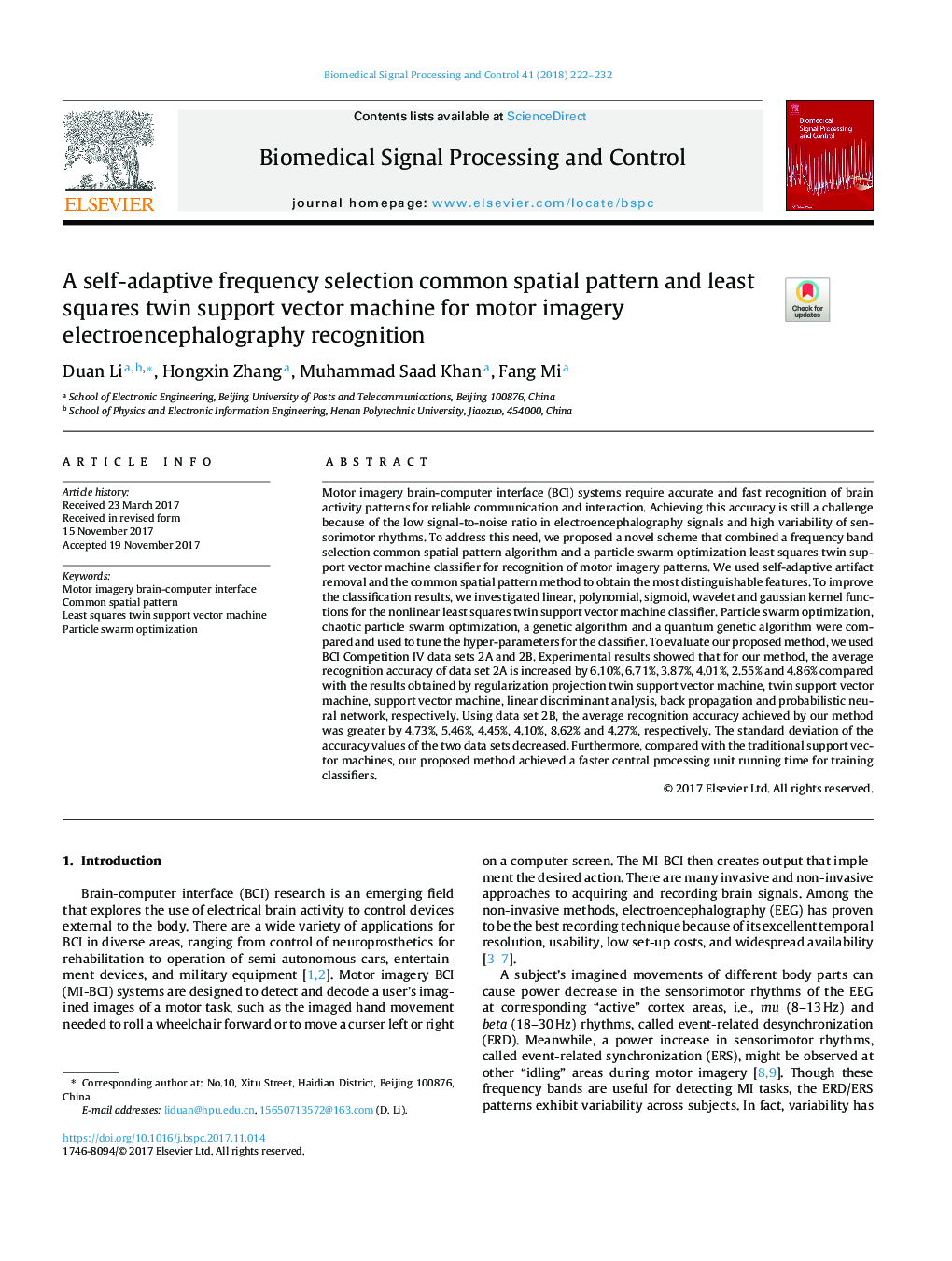| کد مقاله | کد نشریه | سال انتشار | مقاله انگلیسی | نسخه تمام متن |
|---|---|---|---|---|
| 6950973 | 1451639 | 2018 | 11 صفحه PDF | دانلود رایگان |
عنوان انگلیسی مقاله ISI
A self-adaptive frequency selection common spatial pattern and least squares twin support vector machine for motor imagery electroencephalography recognition
ترجمه فارسی عنوان
انتخاب فرکانس خودکارآمد انتخاب الگوی فضای مشترک و کمترین مربعات دو طرفه دستگاه بردار برای تشخیص الکتروانسفالوگرافی تصویر
دانلود مقاله + سفارش ترجمه
دانلود مقاله ISI انگلیسی
رایگان برای ایرانیان
کلمات کلیدی
رابط تصویر مغز و کامپیوتر تصاویر موتور الگوی فضایی مشترک، کمترین مربعات دوتایی دستگاه بردار پشتیبانی، بهینه سازی ذرات ذرات،
موضوعات مرتبط
مهندسی و علوم پایه
مهندسی کامپیوتر
پردازش سیگنال
چکیده انگلیسی
Motor imagery brain-computer interface (BCI) systems require accurate and fast recognition of brain activity patterns for reliable communication and interaction. Achieving this accuracy is still a challenge because of the low signal-to-noise ratio in electroencephalography signals and high variability of sensorimotor rhythms. To address this need, we proposed a novel scheme that combined a frequency band selection common spatial pattern algorithm and a particle swarm optimization least squares twin support vector machine classifier for recognition of motor imagery patterns. We used self-adaptive artifact removal and the common spatial pattern method to obtain the most distinguishable features. To improve the classification results, we investigated linear, polynomial, sigmoid, wavelet and gaussian kernel functions for the nonlinear least squares twin support vector machine classifier. Particle swarm optimization, chaotic particle swarm optimization, a genetic algorithm and a quantum genetic algorithm were compared and used to tune the hyper-parameters for the classifier. To evaluate our proposed method, we used BCI Competition IV data sets 2A and 2B. Experimental results showed that for our method, the average recognition accuracy of data set 2A is increased by 6.10%, 6.71%, 3.87%, 4.01%, 2.55% and 4.86% compared with the results obtained by regularization projection twin support vector machine, twin support vector machine, support vector machine, linear discriminant analysis, back propagation and probabilistic neural network, respectively. Using data set 2B, the average recognition accuracy achieved by our method was greater by 4.73%, 5.46%, 4.45%, 4.10%, 8.62% and 4.27%, respectively. The standard deviation of the accuracy values of the two data sets decreased. Furthermore, compared with the traditional support vector machines, our proposed method achieved a faster central processing unit running time for training classifiers.
ناشر
Database: Elsevier - ScienceDirect (ساینس دایرکت)
Journal: Biomedical Signal Processing and Control - Volume 41, March 2018, Pages 222-232
Journal: Biomedical Signal Processing and Control - Volume 41, March 2018, Pages 222-232
نویسندگان
Duan Li, Hongxin Zhang, Muhammad Saad Khan, Fang Mi,
